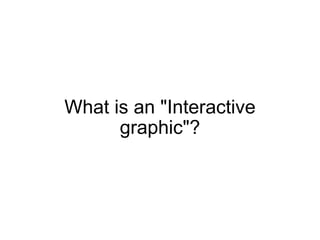Rob Minto
- 1. What is an "Interactive graphic"?
- 2. How do you build them? You will need: - the idea - the data - the people: reporter, designer, coder, editor - the platform - time
- 3. Why do you build them? Topics - what to cover? Originality - what are the competition doing? Niche - what will your audience expect? Setting the agenda
- 4. FT Interative graphics - some examples .... and what did we did right / wrong ? our main list is at www.ft.com/interactive ?
- 10. Elsewhere - (Not all about FT...) There are a lot of great sites doing this, but for ideas check out: ? New York Times Chartporn.org Flowingdata Gapminder datavisualization.ch and I've probably missed some other brilliant ones too...
- 11. Campaign Finance - New York Times
- 12. Guardian - The tax gap
- 13. NYT - Olympic medal map
- 14. What else? Questions, dos and don'ts Do you want your users to "consume" or "interact"? Pick. Give them the data? BEWARE of statistical glitches / anomalies / leaps Don't do it if it's not worth it. Will the story get old fast? Will people care in a week, a month, a year? Will the data change, and are you going to update it? Above all - set the agenda . This is about news, and in the crowded news environment it's hard to stand out. Make a splash. Make the story about your graphic.
Editor's Notes
- #2: There are two types ĻC the Ą°tell a storyĄą type, that make data come to life and give the user a better understanding; and the Ą°work it out yourselfĄą type, which allow the user to play with the variables and find their own story.? ? The first is an extension of traditional journalism, but with far more appealing and engaging presentation.? ? The second is more revolutionary, and allows the audience to become part of the story. ? Turning a spreadsheet into something you can use, or understand.
- #3: I'm not going to talk about audio slideshows. Or video. Or blogs. ? - the idea first question: is this really an interactive graphic? Usually the answer is NO. Shelf life. Appeal. Updatable? - the data Can be harder to come by than you think - People the design skills, a coder - a platform how is anyone going to find this? Promote, plug, shout - time You don't turn these things around in a day
- #4: Topics - what to cover, is it a story that will run for long enough? Events vs themes Originality - or following the crowd Niche - what will your audience expect. E.g. FT and sport. Are you the destination site for EU news? Then do EU data, not BP
- #6: Good - Classic FT story - who owns what? Has long-term value. Bad - Should we have spun a bigger story out of it? Made the text more accessible? ? www.ft.com/carcompanies
- #7: www.ft.com/unconventional Good - use of audio as well as data Bad - doesn't go far enough?
- #8: FTSE100 - FTSE 100: How the share index has changed www.ft.com/ftse100 ? Good - excellent snapshot of how things change ? Bad - data limitations, data availability
- #9: Oil executives pay www.ft.com/ceo-pay ? Good - find your own story ? Bad - data availability?
- #10: Deficit buster www.ft.com/deficitbuster ? Good: Find your own story Was top of the news agenda, cited by Sky, BBC, other papers. The story was written around the graphic. Bad: Give people the data! (again)
- #12: Campaign Finance - New York Times http://elections.nytimes.com/2008/president/campaign-finance/map.html
- #15: Just because you compare it to GDP / Population etc doesn't make it more interesting, or might make it misleading?














